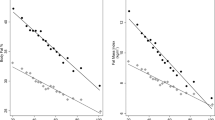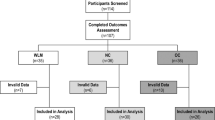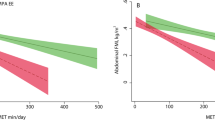Abstract
Background/objectives:
The limited success in addressing the current obesity epidemic reflects the insufficient understanding of the regulation of energy balance. The present study examines the longitudinal association of body weight with physical activity (PA), total daily energy expenditure (TDEE) and total daily energy intake (TDEI).
Subjects/methods:
A total of 195 adults (52% male) between 21 and 35 years of age with no intention for weight loss were followed over a 2-year period. Body weight, fat mass and fat-free mass were measured every 3 months. Participants were stratified into three groups based on change in body weight using a 5% cutpoint. TDEE and time spent in different PA intensities were determined via a multisensor device at each measurement time. TDEI was calculated based on change in body composition and TDEE.
Results:
At 2-year follow-up, 57% of the participants maintained weight, 14% lost weight and 29% gained weight. Average weight change was −6.9±3.4 and 7.1±3.6 kg in the weight-loss and weight-gain groups, respectively. Average TDEE and TDEI did not change significantly in any weight change group (P>0.16). Moderate-to-vigorous PA, however, increased significantly in the weight-loss group (35±49 min/day; P<0.01) and decreased in the weight-gain group (−35±46 min/day; P<0.01).
Conclusions:
Results of this observational study indicate an inverse association between body weight and PA to maintain a stable TDEE and allow for a stable TDEI over time. Sufficient PA levels, therefore, are an important contributor to weight loss maintenance.
This is a preview of subscription content, access via your institution
Access options
Subscribe to this journal
Receive 12 print issues and online access
$259.00 per year
only $21.58 per issue
Buy this article
- Purchase on Springer Link
- Instant access to full article PDF
Prices may be subject to local taxes which are calculated during checkout


Similar content being viewed by others
References
WHO World Health Report 2002: Reducing Risk - Promoting Healthy Life. Geneva: Switzerland, 2002.
Ogden C, Carroll M, Fryar C, Flegal K . Prevalence of Obesity Among Adults and Youth: United States, 2011–2014. NCHS data brief, no. 219, National Center for Health Statistics: Hyattsville, MD, 2015.
Finkelstein EA, Trogdon JG, Cohen JW, Dietz W . Annual medical spending attributable to obesity: payer-and service-specific estimates. Health Aff (Millwood) 2009; 28: w822–w831.
Fontana L, Hu FB . Optimal body weight for health and longevity: bridging basic, clinical, and population research. Aging Cell 2014; 13: 391–400.
Speakman JR . Obesity: the integrated roles of environment and genetics. J Nutr 2004; 134 (8 Suppl), 2090S–2105S.
Redman LM, Heilbronn LK, Martin CK, de Jonge L, Williamson DA, Delany JP et al. Metabolic and behavioral compensations in response to caloric restriction: implications for the maintenance of weight loss. PLoS One 2009; 4: e4377.
Schoeller DA, Thomas D . Energy balance and body composition. World Rev Nutr Diet 2015; 111: 13–18.
Hall KD, Heymsfield SB, Kemnitz JW, Klein S, Schoeller DA, Speakman JR . Energy balance and its components: implications for body weight regulation. Am J Clin Nutr 2012; 95: 989–994.
Blundell JE, Gibbons C, Caudwell P, Finlayson G, Hopkins M . Appetite control and energy balance: impact of exercise. Obes Rev 2015; 16 (Suppl 1), 67–76.
Shook RP, Hand GA, Drenowatz C, Hebert JR, Paluch AE, Blundell JE et al. Low levels of physical activity are associated with dysregulation of energy intake and fat mass gain over 1 year. Am J Clin Nutr 2015; 102: 1332–1338.
Hand G, Blair S . Energy flux and its role in obesity and metabolic disease. US Endocrinology 2014; 10: 59–64.
Pontzer H, Raichlen DA, Wood BM, Mabulla AZ, Racette SB, Marlowe FW . Hunter-gatherer energetics and human obesity. PLoS One 2012; 7: e40503.
Mayer J, Roy P, Mitra KP . Relation between caloric intake, body weight, and physical work: studies in an industrial male population in West Bengal. Am J Clin Nutr 1956; 4: 169–175.
Hand G, Shook R, Paluch A, Baruth M, Crowley P, Jaggers J et al. The Energy Balance Study: the design and baseline results for a longitudinal study of energy balance. Res Q Exerc Sport 2013; 84: 275–286.
Sheehan TJ, DuBrava S, DeChello LM, Fang Z . Rates of weight change for black and white Americans over a twenty year period. Int J Obes Relat Metab Disord 2003; 27: 498–504.
St-Onge M, Mignault D, Allison DB, Rabasa-Lhoret R . Evaluation of a portable device to measure daily energy expenditure in free-living adults. Am J Clin Nutr 2007; 85: 742–749.
Johannsen DL, Calabro MA, Stewart J, Franke W, Rood JC, Welk GJ . Accuracy of armband monitors for measuring daily energy expenditure in healthy adults. Med Sci Sports Exerc 2010; 42: 2134–2140.
Welk GJ, McClain JJ, Eisenmann JC, Wickel EE . Field validation of the MTI Actigraph and BodyMedia armband monitor using the IDEEA monitor. Obesity (Silver Spring) 2007; 15: 918–928.
Casiraghi F, Lertwattanarak R, Luzi L, Chavez AO, Davalli AM, Naegelin T et al. Energy expenditure evaluation in humans and non-human primates by SenseWear Armband. Validation of energy expenditure evaluation by SenseWear Armband by direct comparison with indirect calorimetry. PLoS One 2013; 8: e73651.
Ainsworth BE, Haskell WL, Herrmann SD, Meckes N, Bassett DR, Tudor-Locke C et al2011. Compendium of Physical Activities: a second update of codes and MET values. Med Sci Sports Exerc 2011 43: 1575–1581.
FAO/WHO/UNU Human energy requirements. Report of a joint FAO/WHO/UNU expert consultation. United Nations University, World Health Organization, Food and Agricultural Organization of the United Nations: Rome, Italy, 2004. p 96.
Poslusna K, Ruprich J, de Vries JH, Jakubikova M, van’t Veer P . Misreporting of energy and micronutrient intake estimated by food records and 24 hour recalls, control and adjustment methods in practice. Br J Nutr 2009; 101 (Suppl 2), S73–S85.
Thomas DM, Schoeller DA, Redman LA, Martin CK, Levine JA, Heymsfield SB . A computational model to determine energy intake during weight loss. Am J Clin Nutr 2010; 92: 1326–1331.
Thomas DM, Bouchard C, Church T, Slentz C, Kraus WE, Redman LM et al. Why do individuals not lose more weight from an exercise intervention at a defined dose? An energy balance analysis. Obes Rev 2012; 13: 835–847.
Thomas DM, Martin CK, Heymsfield S, Redman LM, Schoeller DA, Levine JA . A simple model predicting individual weight change in humans. J Biol Dyn 2011; 5: 579–599.
Schoeller DA, Ravussin E, Schutz Y, Acheson KJ, Baertschi P, Jéquier E . Energy expenditure by doubly labeled water: validation in humans and proposed calculation. Am J Physiol 1986; 250 (5 Pt 2), R823–R830.
Trabulsi J, Troiano RP, Subar AF, Sharbaugh C, Kipnis V, Schatzkin A et al. Precision of the doubly labeled water method in a large-scale application: evaluation of a streamlined-dosing protocol in the Observing Protein and Energy Nutrition (OPEN) study. Eur J Clin Nutr 2003; 57: 1370–1377.
Hind K, Oldroyd B, Truscott JG . In vivo precision of the GE Lunar iDXA densitometer for the measurement of total body composition and fat distribution in adults. Eur J Clin Nutr 2011; 65: 140–142.
Schoeller DA . How accurate is self-reported dietary energy intake? Nutr Rev 1990; 48: 373–379.
Heymsfield SB, Thomas D, Nguyen AM, Peng JZ, Martin C, Shen W et al. Voluntary weight loss: systematic review of early phase body composition changes. Obes Rev 2011; 12: e348–e361.
Leonard W . Size counts: evolutionary perspectives on physical activity and body size from early hominids to modern humans. J Phys Act Health 2010; 7 (Suppl 3), S284–S298.
Pontzer H . Constrained total energy expenditure and the evolutionary biology of energy balance. Exerc Sport Sci Rev 2015; 43: 110–116.
Chaput JP, Klingenberg L, Rosenkilde M, Gilbert JA, Tremblay A, Sjödin A . Physical activity plays an important role in body weight regulation. J Obes 2011; 2011: 360257.
Drenowatz C, Cai B, Hand GA, Katzmarzyk PT, Shook RP, Blair SN . Prospective association between body composition, physical activity and energy intake in young adults. Eur J Clin Nutr 2015; 70: 482–487.
Dugas LR, Harders R, Merrill S, Ebersole K, Shoham DA, Rush EC et al. Energy expenditure in adults living in developing compared with industrialized countries: a meta-analysis of doubly labeled water studies. Am J Clin Nutr 2011; 93: 427–441.
Pontzer H, Durazo-Arvizu R, Dugas LR, Plange-Rhule J, Bovet P, Forrester TE et al. Constrained total energy expenditure and metabolic adaptation to physical activity in adult humans. Curr Biol 2016; 26: 410–417.
Drenowatz C . Reciprocal compensation to changes in dietary intake and energy expenditure within the concept of energy balance. Adv Nutr 2015; 6: 592–599.
Swinburn BA, Sacks G, Lo SK, Westerterp KR, Rush EC, Rosenbaum M et al. Estimating the changes in energy flux that characterize the rise in obesity prevalence. Am J Clin Nutr 2009; 89: 1723–1728.
Westerterp KR, Speakman JR . Physical activity energy expenditure has not declined since the 1980s and matches energy expenditures of wild mammals. Int J Obes (Lond) 2008; 32: 1256–1263.
Westerterp KR . Physical activity, food intake, and body weight regulation: insights from doubly labeled water studies. Nutr Rev 2010; 68: 148–154.
Briefel RR, Johnson CL . Secular trends in dietary intake in the United States. Annu Rev Nutr 2004; 24: 401–431.
USDA Agriculture Research Service Nutrient intakes from food: mean amounts consumed per individual, one day, 2005-06, Beltsville, MD, USA. 2008.
Binkley JK, Eales J, Jekanowski M . The relation between dietary change and rising US obesity. Int J Obes Relat Metab Disord 2000; 24: 1032–1039.
Ford ES, Dietz WH . Trends in energy intake among adults in the United States: findings from NHANES. Am J Clin Nutr 2013; 97: 848–853.
Hill J, Levine J, Saris W Energy expenditure and physical activity In: Bray G, Bouchard C (eds) Handbook of Obesity 2nd edn. CRC Press: Boca Raton, FL, 2003 pp 631–654.
Katz DL . Competing dietary claims for weight loss: finding the forest through truculent trees. Annu Rev Public Health 2005; 26: 61–88.
Kruger J, Blanck HM, Gillespie C . Dietary practices, dining out behavior, and physical activity correlates of weight loss maintenance. Prev Chronic Dis 2008; 5: A11.
Catenacci VA, Ogden LG, Stuht J, Phelan S, Wing RR, Hill JO et al. Physical activity patterns in the National Weight Control Registry. Obesity (Silver Spring) 2008; 16: 153–161.
Speakman JR, Levitsky DA, Allison DB, Bray MS, de Castro JM, Clegg DJ et al. Set points, settling points and some alternative models: theoretical options to understand how genes and environments combine to regulate body adiposity. Dis Model Mech 2011; 4: 733–745.
Orsama AL, Mattila E, Ermes M, van Gils M, Wansink B, Korhonen I . Weight rhythms: weight increases during weekends and decreases during weekdays. Obes Facts 2014; 7: 36–47.
Racette SB, Weiss EP, Schechtman KB, Steger-May K, Villareal DT, Obert KA et al. Influence of weekend lifestyle patterns on body weight. Obesity (Silver Spring) 2008; 16: 1826–1830.
Yanovski JA, Yanovski SZ, Sovik KN, Nguyen TT, O’Neil PM, Sebring NG . A prospective study of holiday weight gain. N Engl J Med 2000; 342: 861–867.
Hill JO, Wyatt HR, Peters JC . Energy balance and obesity. Circulation 2012; 126: 126–132.
Flatt JP . Issues and misconceptions about obesity. Obesity (Silver Spring) 2011; 19: 676–686.
Doornweerd S, IJzerman RG, van der Eijk L, Neter JE, van Dongen J, van der Ploeg HP et al. Physical activity and dietary intake in BMI discordant identical twins. Obesity (Silver Spring) 2016; 24: 1349–1355.
Pietiläinen KH, Korkeila M, Bogl LH, Westerterp KR, Yki-Järvinen H, Kaprio J et al. Inaccuracies in food and physical activity diaries of obese subjects: complementary evidence from doubly labeled water and co-twin assessments. Int J Obes (Lond) 2010; 34: 437–445.
Acknowledgements
We thank staff and participants of the Energy Balance Study as well as the scientific advisory board of the study, including D Allison (University of Alabama, Birmingham), J Blundell (University of Leeds, UK), T Church, M Hamilton, P Katzmarzyk (all from the Pennington Biomedical Research Center) and J Jakicic (University of Pittsburgh). Funding for the study was provided by a grant from The Coca-Cola Company. The sponsor played no role in the study design, collection, analysis and interpretation of data, or preparation and submission of this manuscript.
Author contributions
CD has analyzed the data. CD, JOH, JCP and AS-M have interpreted the data and written the manuscript with critical input from SNB. SNB has been the main investigator for the Energy Balance Study.
Author information
Authors and Affiliations
Corresponding author
Ethics declarations
Competing interests
Clemens Drenowatz received travel funding from The Coca Cola Company. James O Hill has been on the advisory boards of The Coca Cola Company, General Mills, McDonalds and Curves. He has been a consultant for Novo Nordisk, and has received grants from Coca-Cola and the American Beverage Association. John C Peters received research support from the Walt Disney Company, American Beverage Association and the McCormick Science Institute. He received consulting fees from the Procter and Gamble Company and from Coca-Cola and a speaker’s fee from McNeil Nutritionals. Steven N Blair has received book royalties (<$5000/year) from Human Kinetics; has served on the Scientific/Medical Advisory Boards for Cancer Fit Steps for Life and Sports Surgery Clinic Dublin; and honoraria for lectures and consultations from scientific, educational and lay groups. During the past 3-year period, he has received research grants from the National Institutes of Health, Body Media and The Coca-Cola Company.
Rights and permissions
About this article
Cite this article
Drenowatz, C., Hill, J., Peters, J. et al. The association of change in physical activity and body weight in the regulation of total energy expenditure. Eur J Clin Nutr 71, 377–382 (2017). https://doi.org/10.1038/ejcn.2016.228
Received:
Revised:
Accepted:
Published:
Issue Date:
DOI: https://doi.org/10.1038/ejcn.2016.228
This article is cited by
-
Compensatory Responses to Exercise Training As Barriers to Weight Loss: Changes in Energy Intake and Non-exercise Physical Activity
Current Nutrition Reports (2023)
-
Hypothalamic control of energy expenditure and thermogenesis
Experimental & Molecular Medicine (2022)
-
The bidirectional associations between leisure time physical activity change and body mass index gain. The Tromsø Study 1974–2016
International Journal of Obesity (2021)
-
Physical Activity in the Prevention of Weight Gain: the Impact of Measurement and Interpretation of Associations
Current Obesity Reports (2019)
-
Revue de Presse
Obésité (2017)



